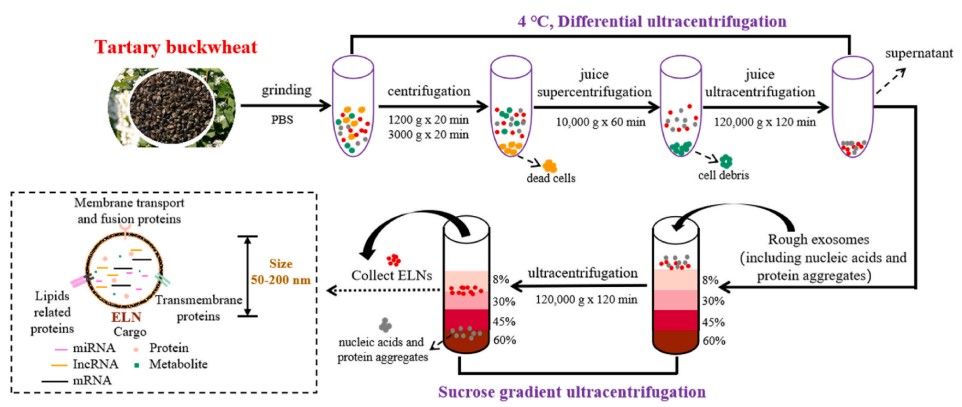Tartary Buckwheat-derived Exosome Research and Application
Tartary buckwheat is a kind of food and medicinal cereal, rich in flavonoids, phenolic acids, rutin, quercetin, and other components, which give buckwheat control of blood glucose, lipid, and blood pressure and other physiological functions. Nanovesicles isolated from tartary buckwheat have typical exosome characteristics and have been shown to not only regulate starch structure and amylase activity to resist starch digestion, but also increase the diversity of intestinal flora, which has a promising application potential. Creative Biolabs provides customized solutions related to tartary buckwheat exosomes to support in-depth research on tartary buckwheat exosomes.
Isolation of Tartary Buckwheat-derived Exosome
-
Ground buckwheat into buckwheat powder using a pulverizer and soluble in PBS.
-
Stir the buckwheat juice at 4°C overnight and filter the crude buckwheat particles.
-
Differential centrifugation of buckwheat juice and then suspension of precipitate in PBS.
-
Purify buckwheat exosomes by sucrose gradient centrifugation, where buckwheat exosomes mainly reside at the 30% - 45% sucrose gradient interface.
-
After centrifugation, suspend the buckwheat exosomes with PBS.
 Fig. 1 Isolation of exosomes from tartary buckwheat.1
Fig. 1 Isolation of exosomes from tartary buckwheat.1
Research on Tartary Buckwheat-derived Exosome
|
Research
|
Conclusion
|
|
Characterization of tartary buckwheat-derived exosome.
|
Tartary buckwheat-derived exosome has an intact cupular structure with a size of 30 - 200 nm and is negatively charged.
|
|
Tartary buckwheat-derived exosome was able to resist the gastrointestinal tract environment.
|
Tartary buckwheat-derived exosome maintained its integrity in a buffer that mimics the environment of the gastrointestinal tract without significant changes in particle size and potential.
|
|
Tartary buckwheat-derived exosome regulation of starch digestion.
|
-
The presence of the tartary buckwheat-derived exosome resulted in a significant reduction in the digestion rate of wheat starch.
-
The effect of tartary buckwheat-derived exosome could greatly reduce the proportion of fast-digesting and slow-digesting starch in wheat starch and increase the proportion of resistant starch, which could be beneficial for controlling the sharp increase of postprandial blood glucose level. In addition, ultrasonic treatment was shown to further enhance the auxiliary effect of tartary buckwheat-derived exosome in effectively inhibiting the digestion of starch.
|
|
Mechanisms by which the tartary buckwheat-derived exosome regulates starch digestion.
|
-
On the one hand, the formation of hydrogen bonds between the polar residues of the tartary buckwheat-derived exosome and the hydroxyl groups of wheat starch was found to facilitate the interaction between the tartary buckwheat-derived exosome and wheat starch. This allowed the starch to form a more ordered complex structure to reduce accessibility of water and digestive enzymes, thus resisting digestion.
-
On the other hand, the tartary buckwheat-derived exosome could compete with starch for binding to the active sites of α-amylase and α-glucosidase through non-covalent binding, which reduces the possibility of starch binding to the enzymes and contributes to slowing down enzyme digestion of starch, thereby effectively slowing down the postprandial glucose elevation.
|
|
Tartary buckwheat-derived exosomes improved the intestinal environment
|
-
Fluorescent tracer signals representing exosomes were detected in the livers and intestines of mice intragastric with the tartary buckwheat-derived exosome.
-
miRNA profiling revealed that miR482c, miR482b, and miR6300 from the tartary buckwheat-derived exosome are involved in the effects of E. coli on the organism, whereas miR3630, novel 1, and miR482b are involved in the process of nucleic acid inheritance in Lactobacillus rhamnosus. Among them, the vesicle structure of the tartary buckwheat-derived exosome protected the miRNAs to facilitate miRNAs to reach the intestine for efficiently regulating the gene expression and species composition of the intestinal flora.
-
The Tartary Buckwheat-derived exosome exerted a positive effect on the proliferation of the intestinal flora in a concentration-dependent manner, increased the diversity of enteric probiotics with bacteriostatic activity, and significantly increased the levels of short-chain fatty acids, thus contributing to the maintenance of homeostasis in the intestinal tract.
|
 Fig. 2 Tartary Buckwheat-derived exosome treatment increased gut microbiota diversity.2
Fig. 2 Tartary Buckwheat-derived exosome treatment increased gut microbiota diversity.2
Tartary buckwheat exosomes encapsulating a variety of functional components from buckwheat can improve intestinal flora and regulate the digestion of starch, and are valuable as drug candidates for digestive-related diseases. Creative Biolabs can provide reliable exosome research services to help clients increase their visibility of the tartary buckwheat exosome. Please contact us to discuss your project.
References
-
Li, Dan, et al. "Tartary buckwheat-derived exosome-like nanovesicles against starch digestion and their interaction mechanism." Food Hydrocolloids 141 (2023): 108739.
-
Liu, Yu, et al. "In vitro effects of Tartary buckwheat-derived nanovesicles on gut microbiota." Journal of Agricultural and Food Chemistry 70.8 (2022): 2616-2629.
For Research Use Only. Cannot be used by patients.
Related Services:

 Fig. 1 Isolation of exosomes from tartary buckwheat.1
Fig. 1 Isolation of exosomes from tartary buckwheat.1
 Fig. 2 Tartary Buckwheat-derived exosome treatment increased gut microbiota diversity.2
Fig. 2 Tartary Buckwheat-derived exosome treatment increased gut microbiota diversity.2









